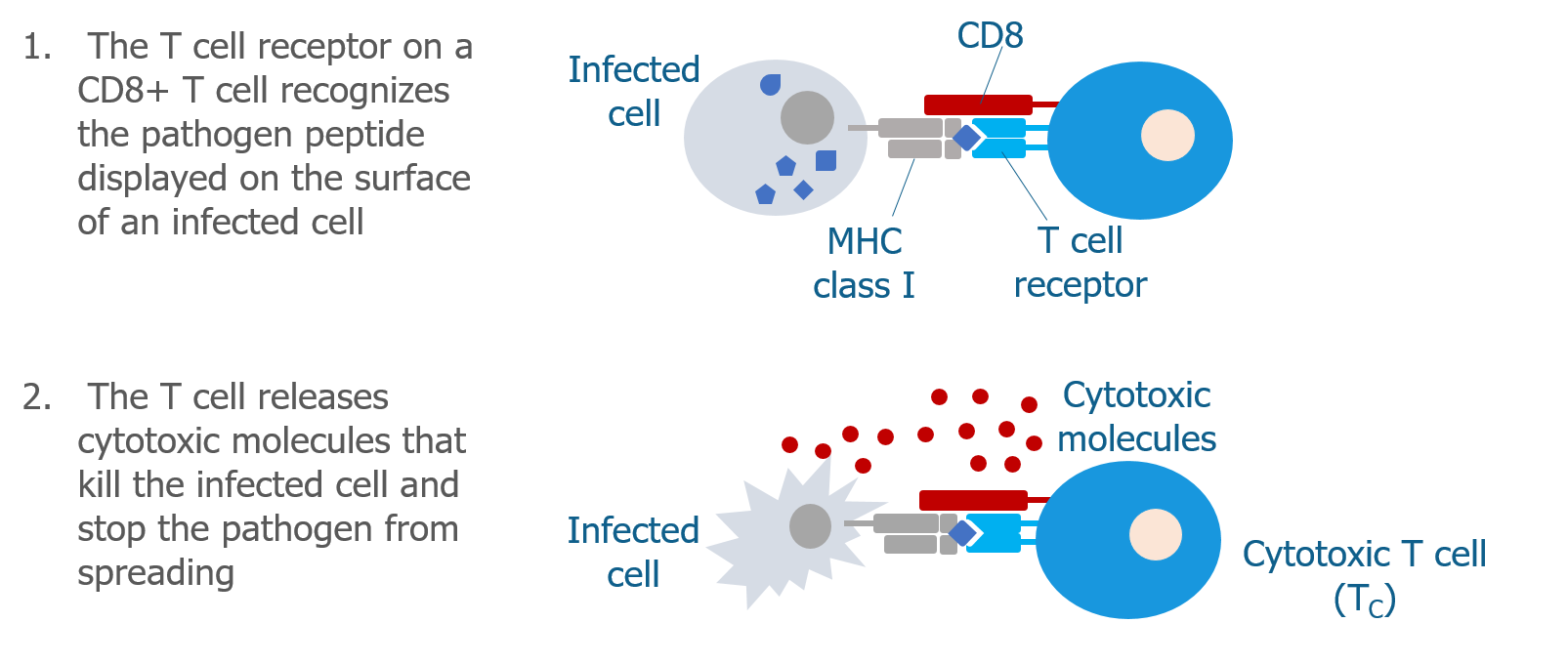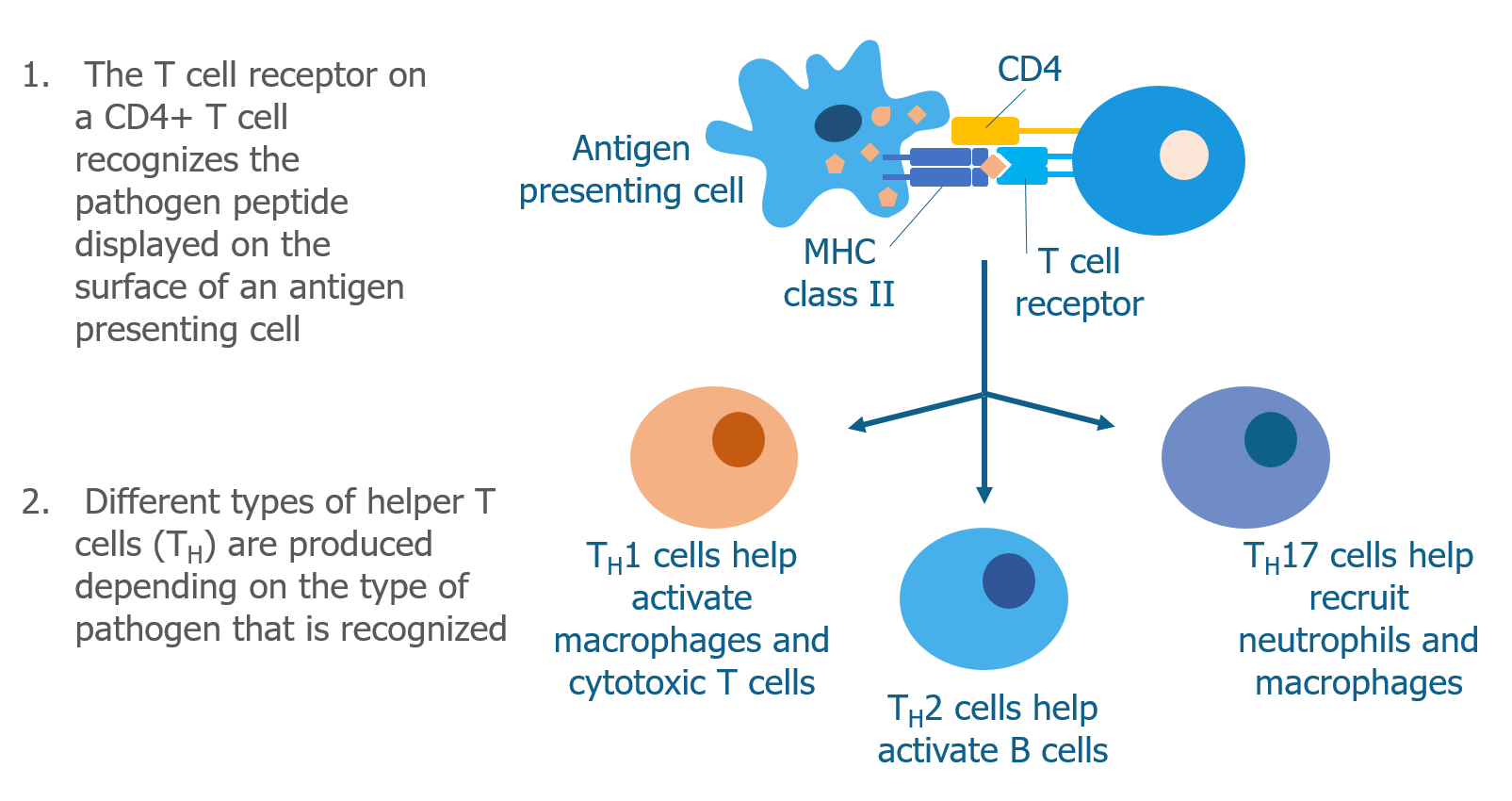There are 3 main types of T cells: cytotoxic, helper, and regulatory. Each of them has a different role in the immune response.
Cytotoxic T cells (CD8+)
Cytotoxic T cells (Tc cells) have a co-receptor called CD8 on their cell surface. CD8 partners with the T cell receptor and with MHC class I molecules, acting as a sort of bridge. This bridge allows cytotoxic T cells to recognize normal cells that are infected by a pathogen. When the cytotoxic T cell recognizes the infected cell, it becomes activated and produces molecules that kill the infected cell, destroying the pathogen in the process.

Helper T cells (CD4+)
Helper T cells (Th cells) have a different co-receptor called CD4 on their cell surface. CD4 also partners with the T cell receptor but interacts with MHC class II molecules instead of MHC class I molecules. This allows helper T cells to recognize pathogen peptides that have been displayed by antigen presenting cells. When helper T cells recognize a peptide on an antigen presenting cell, they become activated and begin to produce molecules called cytokines that signal to other immune cells.
There are many subtypes of helper T cells (ie, Th1, Th2, Th17). Each subtype produces a specialized combination of cytokines that depends on type of pathogen that the helper T cell has recognized—some cytokines are more effective than others in the process of eliminating certain invaders.

Regulatory T cells
Regulatory T cells (Treg cells) also have CD4 on their surface, but they do not activate the immune system like helper T cells do. Instead, regulatory T cells play a protective role by shutting off the immune response when it is no longer needed. This prevents excessive damage to the normal cells and tissues in the body. Regulatory T cells suppress the immune response in several ways, including:
- Producing anti-inflammatory cytokines that suppress the immune response
- Releasing molecules that kill activated immune cells
- Changing the way dendritic cells behave so they can’t activate T cells
Which T cells are involved in celiac disease?
Of the 3 types of T cells described above, the CD4+ T helper cells play a leading role in celiac disease. These are the cells that mistakenly recognize gluten as a pathogen and trigger an immune response (see below).1 However, cytotoxic CD8+ T cells known as intraepithelial lymphocytes (IELs) are also important as they are drivers of tissue damage in the intestine.2
REFERENCES
- Jabri B, Sollid LM. T Cells in Celiac Disease. J Immunol. 2017;198(8):3005-3014.
- Abadie V, Discepolo V, Jabri B. Intraepithelial lymphocytes in celiac disease immunopathology. Semin Immunopathol. 2012;34(4):551-566.
GLOSSARY
Antibodies – Y-shaped proteins that recognize foreign pathogens. Made by B cells. Also called immunoglobulins.
Antigen presenting cell – A specialized immune cell that presents peptides to CD4+ or CD8+ T cells. Peptides are presented by MHC I or MHC II proteins.
CD4 – A co-receptor on the surface of helper T cells.
CD8 – A co-receptor on the surface of cytotoxic T cells.
Cytokines – Small proteins that are made and released by immune cells. Allows cells to send signals and provide instructions to other cells.
Cytotoxic T cell – Adaptive CD8+ immune cell that kill infected cells when activated.
Dendritic cell – A type of antigen presenting cell that processes pathogens and foreign proteins. Presents peptides to T cells.
Helper T cell – Adaptive CD4+ immune cell that produces cytokines when activated.
Immune cells – Specialized white blood cells (also called leukocytes) that fight infection.
Intraepithelial lymphocytes – Cytotoxic CD8+ T cells that reside in the intestine. Contribute to tissue damage in celiac disease.
MHC class I protein – Major histocompatibility complex class I protein. Found on the surface of normal cells. Presents peptides to CD8+ T cells.
MHC class II protein – Major histocompatibility complex class II protein. Found on the surface of antigen presenting cells. Presents peptides to CD4+ T cells.
Pathogens – Bacteria and viruses that can cause disease.
Peptide – A small protein fragment consisting of a chain of amino acids.
Receptor – A protein that is located on the surface of a cell and interacts with other proteins. Receptors act as the “locks” that recognize specific pathogen “keys”.
Regulatory T cell – An adaptive immune cell that suppresses the immune response.
T cell – A type of adaptive immune cell. Also called T lymphocyte.
RELATED
Celiac Disease: Biology Basics
May 17, 2018What Happens In the Small Intestine?
May 6, 2018B Cells
May 6, 2018What Role Does Tissue Transglutaminase (tTG) Play in Celiac Disease?
May 6, 2018Share this Post

13 Comments on “What Are the Different Types of T Cells?”
Very helpful
WHAT ARE DENDRITIC CELLS
EXPLAIN EXTENSIVELY (THE
DENDRITIC CELLS)
A dendritic cell is an type of antigen presenting cell that processes pathogens and foreign proteins. Presents peptides to T cells. Thank you for catching this. We neglected to include that definition in our glossary and it has now been added.
Very helpful
thanks alot
Great. The explanations are clear.
Adding Glossary in the sidebar is a very good initiative.
thank you
very helpful thank you
regulatory and memory cells the same as one?
It is my understanding that they are different.
Clear explanation
Very very helpful thank you
Detailed enough but not too complex (even for a pharmacist :). Thank you so much
Simple explanation I like this.